Rita Ackermann and the Traumas of War

Rita Ackermann, We Mastered the Art of Doing Nothing, 1994 © Rita Ackermann
Rita Ackermann and the Traumas of War
There is a scene in Uli Edel's 1981 film, Christiane F.-We Children from Banhof Zoo, in which Christiane F., going through withdrawal, pukes all over the room and her boyfriend. The film tips, for a second, toward Otto Muehl-type grotesquerie, only to reel back in with Christiane folding into a fetal position. This could be a scene in one of Rita Ackermann's early works, if we delete the boyfriend and recede the withdrawing junky to the background while multiplying her three or four times as she undertakes multiple simultaneous activities.
Paintings such as ‘Cold Turkey with Bon Bons’, 1993, and ‘We Mastered the Life of Doing Nothing’, 1994, are filled with idling and pubescent ‘cat-eyed nymphs’ (a description they can't shake, now that it's been repeated to no end), undressed or on the way there, shooting up or doodling in their notebooks or on the phone or barfing through withdrawal. The paintings are landscapes of late-adolescent ennui, stills from a road movie of runaways trying their luck away from the little provincial towns they've finally managed to flee.
It's a narrative of taut young bodies attempting to carve a refuge out of the edges of the world to which they've been sentenced, to negotiate an Outside-as much a place as an impinging force that rubs raw the edges of everything, not least those of painting itself.
Which is to say that the paint application has as much to do with everything as the figures depicted in these works. By turns Ackermann employs sinuous contour lines and pissed-off paint smearing and clawing. Fingermarks and dragged lines of paint are left there to index emotional turbulence or some such thing. Not in a sappy vein, but with the cold cruelty that kids can muster as placeholders for their disaffection. Interspersed between these two prevalent elements (figure and smear), there are silhouettes that bleed into the raw canvas: fast cars in the distance, Basquiatish figurines, and pictorial incidents that teeter at the edge of accident.
These paintings are like teen diary pictures: one part depiction, one part random stuff, one part non-figurative emotional register. And as such, in groups, they add up to something like a visual bildungsroman-but in reverse, or with an honorable ‘anti’ pegged to it like a band button. On one side, they're not so much stories of coming of age (which is always code for being eased into a proper social role) as a refusal to come of age altogether, translated into a ferocious hewing of social spaces away from the adult world.
That is, these paintings may dive into the turbulent jet streams of teen angst and its dreams of autonomy, but what they ultimately release is the slippery and uncodifiable energy of an exterior not only to these teen elements (to the Acting Out which always has a built-in, prefab impulse to line up again for reincorporation) but to the social contract that they uphold by temporarily refusing. Something other to a dialectic of order and rebellion slips through.
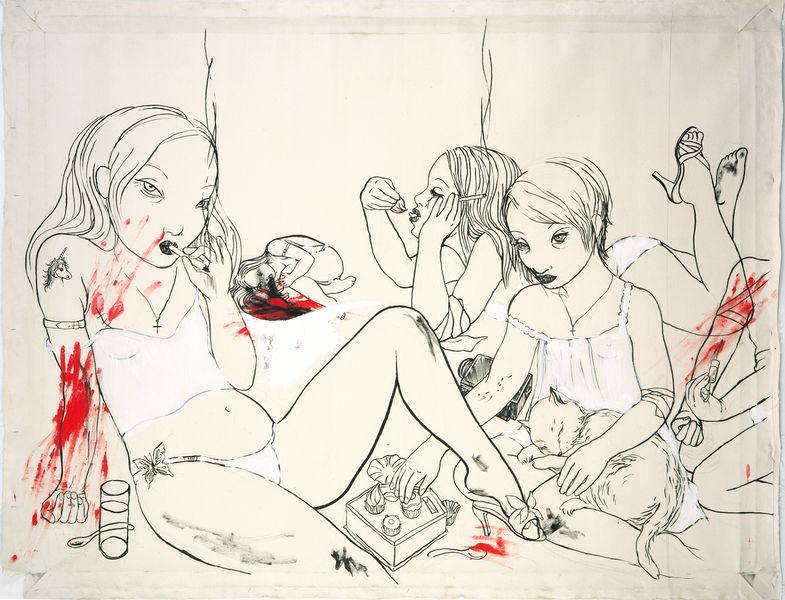
Rita Ackermann, Cold Turkey with Bonbons, 1993 © Rita Ackermann
They are also like a bildungsroman in reverse in another way: there is no one, no single subject, at the center of all this. They're group pictures. Even if the nymphets resemble each other (and Ackermann, as everyone points out), this is hardly a regulator of difference. It's not so much that they are all alike; it's that they've all collapsed an emaciated singularity in order to charge up their group identity, to mark a distance with their surroundings, to tear it from all the other identities that circulate in its vicinity-ravers, class slummers, post-Public Enemy thugs, skaters, etc.
The nymphets mobilize the possibilities and pleasures that undifferentiation affords the group. Which matters, since group dynamics are often what drag bad behavior down a road that bends away from redemption and social reincorporation. Ritual satanic murders, school shootings, pact suicides, Synagogue defacement – these are rarely, if ever, the work of one. Rita Ackermann's work has always felt slightly out of tune with the things that pop up around it – even if it is always also at the center of them.
Whether in relation to the painting that was around in the mid-1990s, when Ackermann began exhibiting, or to the ‘transitive painting’ as defined by David Joselit that some seem to favor these days, her work glides at the edge of things. Not necessarily against the current, just keeping a different time. In other words, New York - her theater of operations – is central to whatever narratives begin to accrue around her work, and yet, like certain things that keep the city from stiffening completely, her work can never be fully contained by it. Ackermann's ways tangle New York's contour lines, redraw what grows there as a way to mark distance from it.
This explains both the lack of place her work seems to embody and the strange sense of having emerged from a particular location and moment, from a downtown scene and around a particular collection of friends. It also explains why the work, rather than falling in line with up-to-date stylistic and discursive demands or lip-syncing to the medium's doom-bound lyrics, acquires by turns the feeling of politically-soaked figuration (think CoBrA, Dubuffet, or Otra Figuraciôn), precocious high school doodling and teen-diary production, and the mud-flap-and-beer-sludge abstraction of Walmarted towns.
Though some might mistake them for very Now and very New York, whatever that is or entails, Ackermann's paintings can never shake the fact that they mark an Outside – even if they are always put together by harnessing the energies that circulate at the center of it all. A few people who have written about Ackermann have pointed out, mostly in passing or in attempting a clever turn, that she is Hungarian and works in exile. I have never understood what they mean by this. When I read this, I imagine working in one place – although not being there at all – while thinking of another.
It has to do with investing energy in territory one has been banished from. I think it was Mary McCarthy who proposed that exiles are people whose entire being is spent in waiting – waiting for something to change back home, for news from family and other dissidents, for attacks from hostile quarters, for opportunities to explain things to the world. I don't see this in Ackermann. I wouldn't even call her an expat. She embodies a different condition, something closer to being a runaway.
It's a different kind of subjectivity, shaped by other investments and anxieties. It has little to do with being concerned with what is happening back home and much more to do with figuring out how to make one's inevitably accented work and foreign body whittle a slot – its own slot – in the homogenous field of local expression. A field that. by the very impulse to reproduce that underscores it. is inherently hostile to anything that comes in from the outside. Ackermann's work has to do with arriving. And it concerns Itself with this because it's only after arriving, and right before adaptation or acclimation begin their stultifying processes, that one can take flight again, exercising continuous displacement as a way of developing a body of heterogenous but coherent work.
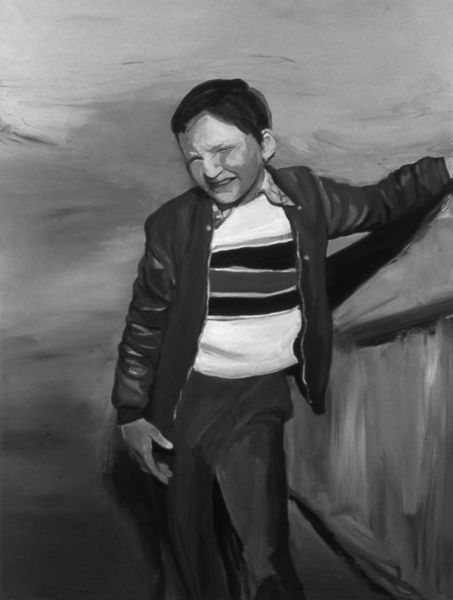
Rita Ackermann, When My Voice Broke, 1995 © Rita Ackermann
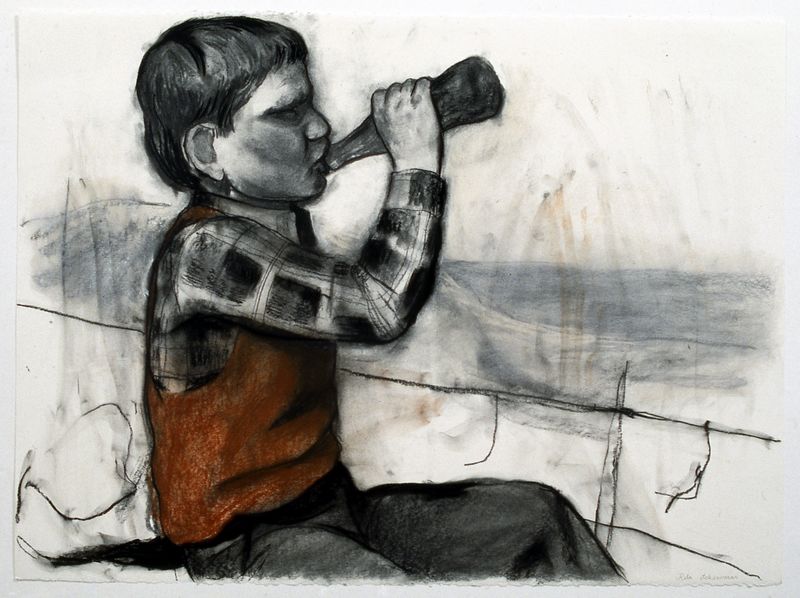
Rita Ackermann, …And I Can Break Glass with My Voice…, 1995 © Rita Ackermann
After the early nymphet paintings, Ackermann produced a series of paintings of her brother as a boy. They disengaged from the drive to register disaffection directly on the surface. Set in the countryside, with mountains in the background, they are finished in the way that the earlier work wasn't. I've never quite known what to make of ‘…And I Can Break Glass with My Voice…’, 1995, ‘When My Voice Broke’, 1995, and the rest of the group. I've always wondered if the charge they generated when first shown, the shock of rupturing with the style of the work that preceded them and perhaps with a prevalent downtown aesthetic, is necessary to get what they are going after.
If the counterpoint, articulated in real time, between the two bodies of work was part of what was going on, then I've no way (or desire) to project myself into that moment. The advantage of this is that I have to approach these paintings the same way that most of the viewers who weren't there, in New York, in 1996, when they were first exhibited, will have to. And this opens other readings. For me, these paintings make the most sense when retro-coded by the work that came after them, by the indispensable ballpoint pen attacks of the mid-1990s.
Tainted by the dark undercurrent cast from future production. I cannot help but read Ackermann's paintings of her brother refracted through a kind of cinematic cliché of the innocent boy waiting for war, the antecedent to the damaged creatures that result from the meltdown. These paintings are like the nostalgic snapshots that preface apocalyptic films, markers that help us understand the magnitude of the disaster. The disaster itself is registered in the ballpoint pen paintings, in objects such as ‘The Ugly Painting’, 1996-97, ‘Filthy Bitches…’, 1997, ‘Ladies Deserve to Be Slaves’, 1997, and, perhaps most impressively, in ‘World War III Around My Skull’, 1996-97, a painting that's a massive discharge of raw energy channeled through charging horses, ancient warriors, bunker imagery, and a diarrheal explosion of mark-making.
All these things are organized in layers that are coming undone as intense lines cut through them and shoot past the edges of the canvas. It's the world disintegrating. But it is also – as controlled shock, as war-as-theater – an exercise in erecting psychic barriers against the war world that is being depicted. In this way, rubbing up against the millennium, these paintings take us back to the beginning of modernism, when the art object, dissenting from the safety of academic manners and codes, became a filter through which we could absorb the massive traumas that industrialization and bureaucratization ushered in.
If Walter Benjamin found this latter process at work in Baudelaire and Kafka, we find it in Ackermann, but with this difference: it's not the deadening repetition of industrialization and opaque labyrinthine logic of bureaucracy that psychically assault us; it's the rampant proliferation of electronic and digital technology. its advances into every corner of everyday life, its gadgeting of the world; it's the new regimes of control and finance that it fosters and facilitates, the enlarged field of automatisms it demands, and the hypermediated spaces it sentences us to. (The last ballpoint pen work produced at this time, ‘Ain't the Devil is Happy II’, 1997 – which depicts the Unabomber and implicates his technophobic worldview – I think ratifies all this, like a coda that clarifies any ambiguities in the body of work that it closes.)
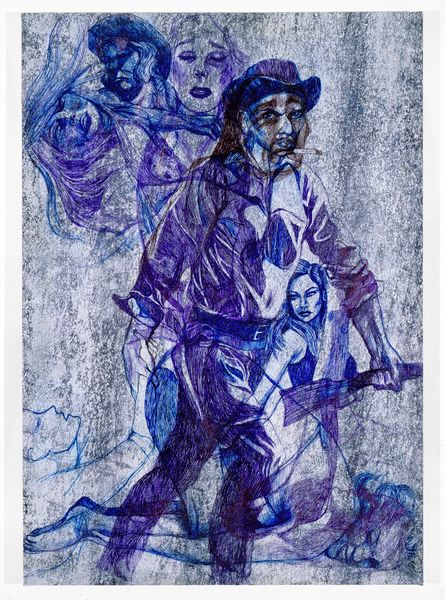
Rita Ackermann, Ladies Deserve to Be Slaves, 1997 © Rita Ackermann
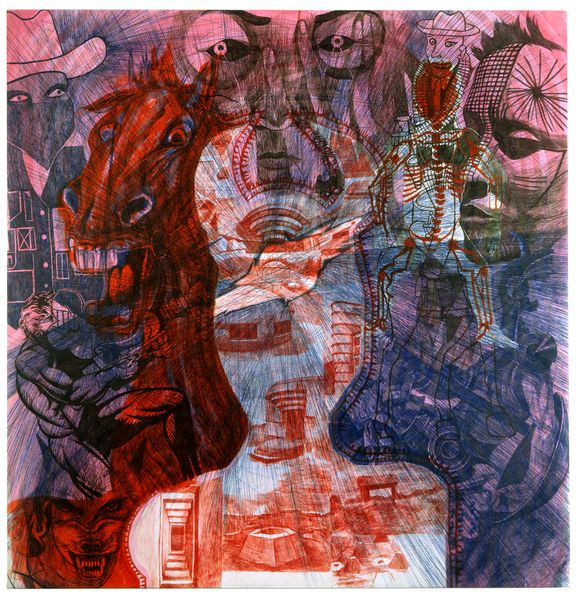
Rita Ackermann, World War III Around My Skull, 1996-1997. Courtesy the artist and Hauser & Wirth.
What we are dealing with here is both painting and subjectivity pierced by technology. The ballpoint pen – one thinks of the ubiquitous Bic Cristal and what it meant when it first appeared, marrying the lucidity of modern design with the efficacy of mass production – is a mere stand-in for the operations that technology unleashes on flesh, for technology's ambivalent or shifting status, as its inventions slide from being instruments of aid and comfort to becoming weapons of automated depredation and annihilation.
The ballpoint pen is here emblematic of all the instruments that inscribe a warring body. Its physical scratchings and defacings moonlight as an attack on mushier psychic surfaces. The Bic pen, innocuous from a distance, is here amplified into the remarkable apparatus in Kafka's penal colony, once we imagine the latter with its cogs and wheels replaced by software algorithms. The echo of the pen's scratchy lines, as it must have bounced off the walls of Ackermann's studio while the paintings were being made, keeps time with the rise and fall of the harrow as its needles pierce flesh, with the streams of code and data that traverse us incessantly to the contagious rhythms of commerce.
As in so many of Kafka's stories. In these paintings beauty is an attribute of the condemned body. That a set of collages based on ‘Ubu Roi’, Alfred Jarry's famous absurdist play, was produced in parallel to these ballpoint pen paintings makes sense. These, too, draw a connection to the nineteenth century and tie it up to our moment. Not only by being based on a play that premiered in 1898, but by relying on newspapers and magazines for its imagery – media that proliferated at the time, but also technology at the service of gutting language and, like Père Ubu, sense.
Perhaps more importantly, in light of what they anticipate, these collages also sketch a vague subterranean line to Joan Miró’s Barcelona Series lithographs, produced during the Spanish Civil War, and to his Ubu Roi prints from the 1960s. In both of these sets of multiples, we find a wild discombobulation of anthropomorphic vocabularies that will come to rhyme with Ackermann's future production, in which bodies dissolved simultaneously into strange modulations of themselves and into charged pictorial spaces.
One thinks of the ineffable and paradoxically stately-abject ‘Negative Muscle’, 2010, as example. The ‘body’ in it could be one of Miró’s perverse morphologies put through the War on Terror or jammed in some interfacial limbo during one of the countless dissolutions into networks that we practice. In the wake of these ballpoint pen efforts, which mark an important moment of genesis for Ackermann's current work, painting arises irreparably war-damaged, flesh-melted, and steeled to face down stranger territory, to contemplate weirder thrivings.
Collage, which has always been the secret core of Ackermann's work, steps to the foreground and becomes the operation of latching on prosthetics to supplement the broken-veteran body of painting. But of course the idea of supplementarity – with its positive inflection – is here the ultimate ghost limb. Collage's prostheses work less by mending and improving than by tearing things up and scarring in ever stranger ways, by disfiguring more radically and inducing mutation with less and less mercy.
If the body was once slashed and carved, it now rises grafted with strange appendages – magazine and tabloid pages, posters, sand, fabrics, photocopies of older work, shattered wine-glasses, apples. Like the bodies of Kafka's assistants and clerks, in particular like Samsa's body with an apple lodged in its carapace, these bodies awaken with unfathomable parts protruding out of them.
Or, in a kind of operation that is both the opposite of and identical to this, with their parts melted away. Flesh becomes indistinguishable from what is around it. Edges fade. Either case underscores the fact that, if once the canvas was for Ackermann a site on which to deposit a narrative, it is now a magma pool on which things crust and fuse.
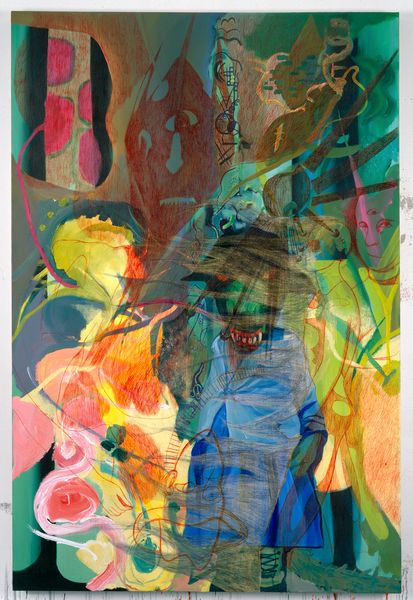
Rita Ackermann, The Ugly Painting, 1996-1997 © Rita Ackermann
During the second half of the first decade of the twenty-first century, these two processes – the addition of incongruent parts and dissolution of figures into meaty surfaces-became prevalent and shared equal shifts in the production line. ‘DO'S AND DONT'S NURSES (UNITED)’, 2008-9, is an unhinged compendium of appendages. Material from everywhere is lumped together, unburdened by the demands of smooth synthesis. The freewheeling combinatory potential that digital technologies have pushed to the forefront of cultural production is here ushered to one of its darker sides.
In ready to ‘fuck——again’, 2005-8, three nymphets return, but less as teen squatters in pictorial space than as three movements In the fusion of one kind of matter with another – paint with sand, flesh with fabric. Group disintegration as a collective effort marks an important difference in the bodies that populate the newer paintings. They return as a pack, in Deleuze and Guattari's sense – as elements defined in relation to one another and to the field of intensities that they generate through these relations.
The assemblage, the veteran-body, is formed here not only by depicted and discrete bodies. It's formed by all the elements present, as every edge becomes permeable or ambiguous. Figures, textures, marks, negative and positive spaces, modes of paint application, foreign objects, orientation – they all form a single and complex articulation, as contingent elements in tense exchange, a continuum marked by peeks of intensity rather than by refined formal dialogue.
To think of figure or ground here is to apply an expired vocabulary to objects that strive to be outside the possibilities that these allow. ‘IN DA SHADE’, 2008, is a charged and crusty field, an earthily messy configuration. Things happen in it. Its logic is based less on privileged points (composition) or tropes than in charged relations structured and stimulated by contingent encounters, by mutual deformations and interferences, by particular investments of energy and immanent discordance. Indeterminacy Is the chasm it's all held out over.

Rita Ackermann, ‘IN DA SHADE’, 2008 © Rita Ackermann

Rita Ackermann, DO'S AND DONT'S NURSES (UNITED), 2008-2009 © Rita Ackermann
‘IN DA SHADE’ joins much of Ackermann's most recent production – some works, of course, are more successful than others, as is always the case – in becoming subject of its own process, a pictorial apparatus is calibrated to generate only its singular expression, to activate possibilities that emerge only along the way. There is no ideal compositional balance or aim sought to guide the effort, no external metric to judge the work's success. It's only the experimentation, which has as much to do with cumulative effects as with negational gestures and undermining, with the piling up of contradictory elements and disjunctions, that slowly congeals into something.
Whatever tension and affective charge the work ends up with is intrinsic to its development. But it's not process art, whose goal is always buried in its procedure, a little bit like method acting, but a machine that ruthlessly disorganizes its own forms and tears itself from expectation. In this way, painting – how to say this without making it sound like panpsychic mysticism? – discovers its powers. It becomes something that a subject needs to plug into, rather than the other way around.
Which is another way to say that Ackermann's paintings have gotten away from her, in the same way that one can imagine a singer finding that her voice isn't what she hears in recordings. The voice has sped ahead of the body it is bound to. This body will have to run it down from that moment on. It's the same for Ackermann. Her paintings feel as if they can turn themselves into intense fields of tension by dismantling incessantly whatever forms and materials are applied to them.
Disjunction and incommensurability animate them. They've arrived at a strange threshold of production, they seem to make themselves. In fact, each is a testament to Ackermann's tenacious catching up to them and the work's indefatigable drive to push on, to stay ahead of the body that makes them.
Related News
1 / 5




